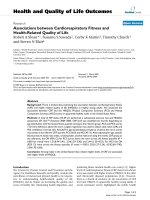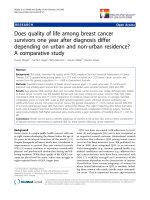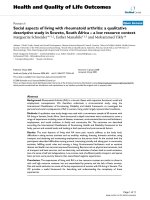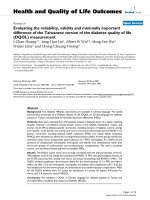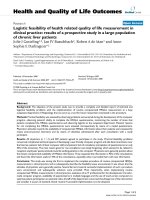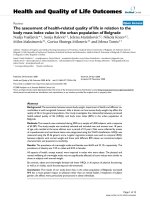báo cáo hóa học:" Health-related quality of life and physical well-being among a 63-year-old cohort of women with androgenetic alopecia; a Finnish population-based study" pot
Bạn đang xem bản rút gọn của tài liệu. Xem và tải ngay bản đầy đủ của tài liệu tại đây (252.97 KB, 7 trang )
BioMed Central
Page 1 of 7
(page number not for citation purposes)
Health and Quality of Life Outcomes
Open Access
Research
Health-related quality of life and physical well-being among a
63-year-old cohort of women with androgenetic alopecia; a Finnish
population-based study
Päivi Hirsso*
1,2
, Ulla Rajala
1
, Mauri Laakso
1,2
, Liisa Hiltunen
1,2,3
,
Pirjo Härkönen
1,4
and Sirkka Keinänen-Kiukaanniemi
1,3
Address:
1
Department of Public Health Science and General Practice, Box 5000, FIN-90014 University of Oulu, Finland,
2
Unit of General Practice,
Oulu University Hospital, FIN-90029 OYS, Finland,
3
Oulu Health Center, Box 8, FIN-90015 City of Oulu, Finland and
4
Oulu Deaconess Institute
Department of Sports Medicine, Finland
Email: Päivi Hirsso* - ; Ulla Rajala - ; Mauri Laakso - ;
Liisa Hiltunen - ; Pirjo Härkönen - ; Sirkka Keinänen-Kiukaanniemi -
* Corresponding author
androgenic alopeciahair lossinsulin resistancehealth related quality of life
Abstract
Background: The aim of this study was to assess the possible associations between female
androgenetic alopecia (AGA), insulin resistance and health-related quality of life (HRQOL)-linked
factors in women. We hypothesized that not only the mental aspects but also certain physical
aspect of women's health, such as insulin resistance, have an important role in the determination
of HRQOL among women with hair loss.
Methods: A population-based cohort of 330 healthy women aged 63 years, who participated in
this study in the City of Oulu in Northern Finland, underwent a medical check-up including
assessment of hair status on Ludwig's scale. Background data were collected with a standard
questionnaire including a validated RAND 36-Item Health Survey (RAND-36) questionnaire.
Results: 105 (31%) women with AGA and 225 (69%) controls completed the RAND-36
questionnaire. The women with AGA were more insulin-resistant than the women with normal
hair (QUICKI 0.337 vs. 0.346, p = 0.012). Impaired glucose regulation (IGR) was more prevalent
among the former than the latter group (39% vs. 25%). The mean RAND-36 scores were
significantly lower on the dimensions of physical functioning, role limitation due to physical health
and general health, but not on the mental or social dimensions, among the women with AGA
compared with the controls. In multivariate logistic regression analyses with the lowest quintiles of
the HRQOL dimensions as the dependent variables and AGA, depression, marital status, education
and IGR or QUICKI as independent variables, AGA was independently associated with role
limitations due to physical health (2.2, 95% CI 1.20–4.05, 2.45 95% CI 1.32–4.55, respectively).
Published: 24 August 2005
Health and Quality of Life Outcomes 2005, 3:49 doi:10.1186/1477-7525-3-
49
Received: 25 April 2005
Accepted: 24 August 2005
This article is available from: />© 2005 Hirsso et al; licensee BioMed Central Ltd.
This is an Open Access article distributed under the terms of the Creative Commons Attribution License ( />),
which permits unrestricted use, distribution, and reproduction in any medium, provided the original work is properly cited.
Health and Quality of Life Outcomes 2005, 3:49 />Page 2 of 7
(page number not for citation purposes)
Conclusion: In women aged 63 years, AGA was associated with role limitations due to physical
health. Furthermore, the prevalence rates of IGR and insulin resistance measured by QUICKI were
higher among the women with hair loss than those with normal hair.
Background
Androgenetic alopecia (AGA) has been observed in
women, with an increasing prevalence particularly after
the age of 50 years [1]. Moreover, it has been suggested
that hair loss could have an adverse effect on psychosocial
life and self-esteem among both genders [2-7]. A number
of studies have shown that, in selected clinical popula-
tions, androgenic alopecia is associated with poorer qual-
ity of life scores on disease-specific quality of life
questionnaires [8,9]. Women with AGA describe their
self-perceived health and psychosocial situation more
negatively (e.g. low self-esteem, emotional distress due to
AGA, social anxiety) than those with normal hair
[2,5,8,9]. In addition, one study suggested that hair loss in
women could be associated with psychiatric disorders, e.g.
depression [3].
It is unclear why women with AGA would have a poorer
quality of life. As most studies have looked at these asso-
ciations in subgroups of women with underlying illness,
it is plausible that the women with AGA may have an
underlying subclinical disease. In males, an association
between AGA and insulin resistance has been demon-
strated [10,11], but the data on women are less conclusive
[12].
We explored the association between AGA and various
dimensions of HRQOL among community-dwelling
women. We further explored whether any differences in
the quality of life between those with and without AGA
could be explained by an underlying metabolic abnormal-
ity. The aim of this study was to assess the potential asso-
ciations between AGA, insulin resistance (IR) and the
different HRQOL dimensions among women at the pop-
ulation level.
Methods
A population-based study was carried out in northern Fin-
land in 1990–1992 to assess, among other things, the
prevalence of diabetes mellitus (DM) and impaired glu-
cose tolerance (IGT). Altogether 831 subjects (435
women) born in 1935 and living in Oulu, a city with
100,000 inhabitants, participated in the study. They were
invited to attend a follow-up study in 1996–1998, and
593(71%) subjects (347 women, 83%) attended. A
detailed description of the data has been published earlier
[13].
As part of the clinical examination, hair status (330
women, 93% of those participated) was assessed by the
same trained nurse, using Ludwig's scale [14], and re-clas-
sified into two classes for the analysis. The original classes
0 and I (no or minimal hair loss) were combined as a nor-
mal hair group and the original classes II and III (moder-
ate or marked hair loss) were combined as a hair loss
group.
We measured health-related quality of life (HRQOL)
using the Finnish version of the RAND 36-Item Health
Survey 1.0 (RAND-36) [15]. This self-reported measure is
composed of eight separate scales assessing physical func-
tioning (10 items), role limitations due to physical health
(4 items), role limitations due to emotional problems (3
items), energy/fatigue (4 items), emotional well-being (5
items), social functioning (2 items), pain (2 items) and
general health (5 items). All scale scores range from 0 to
100, with 100 representing the most favourable function-
ing/well-being, and the minimal clinically important dif-
ference is cautiously suggested to be 3–5 points [16,17].
RAND-36 [18] includes the same items as the Item Short-
Form Health Survey SF-36 [19], but the scoring algorithm
has been slightly modified [18].
From the questionnaires, we assessed various sociodemo-
graphic variables, including the respondents' current mar-
ital status (married, unmarried/divorced or widowed) and
educational attainment (elementary, secondary or univer-
sity). Self-perceived health and the participant's own
opinion of his or her overall physical fitness and life satis-
faction were also asked (good, moderate or poor). A sum
score of overall physical capacity was constructed based
on their ability to walk up one flight of steps, a few flights
of steps, half a kilometre or two kilometres or to run one
hundred metres. The total score ranged from 0 to 20, with
a higher score indicating poorer physical capacity. Depres-
sive symptoms were measured using the Beck Depression
Inventory (BDI) [20] with scores ≥ 10 defined as indica-
tive of depressive symptoms.
Anthropometric measurements (weight, height, waist cir-
cumference and hip circumference) were obtained and
used to calculate body mass index (weight/height
2
) (BMI)
and waist-to-hip ratio (WHR). Blood pressure (BP) was
measured by a physician from both arms in a sitting posi-
tion. The mean value of these two measurements was used
in the analyses. Hypertension was defined as either a
systolic blood pressure ≥ 160 mmHg or a diastolic blood
Health and Quality of Life Outcomes 2005, 3:49 />Page 3 of 7
(page number not for citation purposes)
pressure ≥ 90 mmHg or being on antihypertensive medi-
cation regardless of the blood pressure values. Prevalent
chronic disease (hypertension, ischemic heart disease,
diabetes, stroke, intermittent claudication, arthritis) was
based on a medical diagnosis as reported by the partici-
pant on the questionnaire or the use of medication for any
of these diseases as reported during the clinical
examination.
After an overnight fast, blood samples were collected
using a standardized procedure and assayed for blood glu-
cose (fB-gluc), two-hour blood glucose concentration (2
h-gluc) and serum insulin (excluding diabetic patients
with insulin treatment). A standardized 75-g oral glucose
tolerance test (OGTT) was performed. We defined the par-
ticipants as having impaired glucose regulation (IGR) if
they met the criteria for having impaired fasting glucose
(IFG), IGT and DM based on the WHO 1997 criteria [21].
To measure insulin sensitivity, a quantitative insulin sen-
sitivity check index (QUICKI) was used [22,23]. QUICKI
was determined from the fasting insulin and glucose val-
ues according to the equation: QUICKI = 1/ [log(fasting
insulin) + log(fasting glucose)]. Diabetic subjects with
antidiabetic medication were excluded from the analysis.
Statistical analyses
For these analyses, we used data from 347 women with
complete hair status scores (n = 330). Descriptive compar-
isons of the groups defined by hair status were presented
as cross-tabulations and percentages for the categorical
variables and assessed with the T-test when the distribu-
tion was normal or with the Mann-Whitney U-test in the
case of a non-normal distribution of the continuous vari-
ables. The statistical differences between the scores of the
HRQOL dimensions were tested by the Mann-Whitney U-
test [24]. The HRQOL dimensions on which the women
with significant hair loss scored lower than the women
with normal hair were analyzed in more detail. After
bivariate comparisons, multivariate logistic regression
analyses with the lowest quintile of HRQOL as the
dependent variables and AGA, BDI, IGR/QUICKI, marital
status and education as independent variables were made.
The possible interactions of hair status with depression
(AGA*BDI) and impaired glucose regulation with depres-
sion (IGR*BDI) were tested by interaction terms.
Results
The prevalence of moderate to marked hair loss (grade II-
III on Ludwig's scale) was 31% among the study popula-
tion. Table 1 gives the percentages and Table 2 gives the
means of the background characteristics of the women
stratified into the categories of normal hair (grade 0 and I
on Ludwig's scale) and hair loss (grades II and III on Lud-
wig's scale). In bivariate analysis, the women with hair
loss had statistically significantly lower self-perceived
health, self-perceived physical fitness and life satisfaction
compared to the women with normal hair. (Table 1)
Waist circumference and WHR were significantly higher
and BMI tended to be higher (p = 0.094) among the
women with hair loss compared with those with normal
hair status. The mean QUICKI was lower, indicating
higher IR, in the women with hair loss compared with the
women with normal hair. (Table 2) The sum score of
overall physical capacity was significantly higher (describ-
ing the limitation in physical functions) among the
women with hair loss compared with the women with
normal hair (mean sum score 7.9 ± 3.1 vs. 7.2 ± 2.8, p =
0.015).
There were no significant differences between the hair sta-
tus categories of the women reporting heart failure, hyper-
tension or musculoskeletal symptoms, but the women
with hair loss self-reported more DM than those with nor-
mal hair (14% vs. 6%). The corresponding prevalences for
IFG and IGT were as follows (2% vs. 5%, 24% vs.16%,
respectively). The prevalence of IGR (cluster of self-
reported DM and IFG, IGT and DM according to OGTT)
defined by WHO was different between the groups (43%
vs. 30%, p = 0.015).
The women with hair loss scored significantly lower on
the physical functioning, role limitations due to physical
health and general health perceptions dimensions of
HRQOL compared with the women having normal hair.
Also, a nearly statistical significant difference was seen in
the pain score between the groups. (Table 3).
The interaction terms of depression with hair loss and
depression with IGR were not statistically significant, sug-
gesting that the effects of hair loss and IGR on the dimen-
sions of HRQOL were not different in depressive and non-
depressive subjects. The multivariate logistic regression
analyses were made to analyze the independent associa-
tion of AGA with the HRQOL dimensions. Two different
adjusted models are presented in Table 4. In model a),
glucose status is presented as IGR, and in model b), glu-
cose metabolism is described with QUICKI. Because
depressive symptoms, marital status and education are
associated with HRQOL, they were included in the mod-
els as confounding factors. In both models AGA was inde-
pendently associated with role limitations due to the
physical health dimension of HRQOL, the odd rations
being 2.2 (1.20–4.05) in model a) and 2.45 (1.32–4.55)
in model b). In the dimensions of physical functioning
and general health, no such association between AGA and
HRQOL was seen. In addition, depressive symptoms were
independently associated with role limitations due to
physical health and general health.
Health and Quality of Life Outcomes 2005, 3:49 />Page 4 of 7
(page number not for citation purposes)
Discussion
The main finding of this study was that women with AGA
had impaired self-perceived health. They were more insu-
lin-resistant when measured by QUICKI as a marker of
insulin sensitivity, and impaired glucose regulation was
more prevalent among them compared with the women
with normal hair. The women with AGA had significantly
higher waist circumference and WHR values as markers of
abdominal obesity than the women with normal hair.
Compared with the women having normal hair, the
women with AGA scored significantly lower on three of
the eight RAND-36 dimensions: physical functioning,
role limitations due to physical health and general health
items compared with the women having normal hair. In
addition, the scores on all the other RAND-36 dimensions
except emotional well-being tended to be lower.
This is the first study of an unselected and representative
population of women to report an association of AGA
with the general measures of HRQOL, which are recom-
Table 1: Percentages of some background characteristics among the study groups
Variable Hair loss (n = 105) Normal hair (n = 225)
% (n) % (n) p
Marital status 0.163
married 59 (61) 69 (154)
not married/divorced 27 (28) 18 (41)
widow 14 (14) 13 (29)
Educational level 0.115
elementary 89 (92) 80 (181)
secondary 5 (5) 11 (25)
tertiary 6 (6) 8 (19)
Self-perceived health 0.030
good 41 (43) 54 (121)
moderate 48 (50) 42 (94)
poor 11 (11) 4 (10)
Self-perceived physical fitness 0.001
good 26 (27) 46 (104)
moderate 54 (56) 44 (99)
poor 20 (21) 10 (22)
Life satisfaction 0.044
satisfied 66 (69) 79 (176)
moderately satisfied 32 (34) 20 (45)
dissatisfied 2 (2) 1 (3)
BDI
1)
0.311
no depression 76 (78) 83 (173)
depressive symptoms 22 (21) 17 (35)
1)
BDI = Beck's Depression Inventory; cut point ≥ 10
Table 2: Mean and standard deviations (SD) of background characteristics among women with hair loss and normal hair
Variable Hair loss n = 105 Normal hair n = 225
Mean Sd Mean Sd p
Waist circ. (cm) 86.6 11.4 83.0 10.9 0.010
BMI
1)
(kg/m
2
) 28.5 4.5 27.5 4.0 0.094
WHR
2)
(waist/hip) 0.84 0.06 0.81 0.06 0.002
fB-gluc
3)
(mmol/l) 5.2 1.0 5.0 0.8 0.064
2-h gluc
4)
(mmol/l) 7.2 1.8 7.1 1.8 0.321
QUICKI
5)
0.337 0.03 0.346 0.03 0.012
1)
BMI = body mass index (kg/m
2
);
2)
WHR = waist to hip ratio;
3)
fB-gluc = fasting glucose level (mmol/l);
4)
2-h gluc = 2-h blood glucose level (mmol/
l);
5)
QUICKI = Qualitative Insulin Sensitivity Check Index
Health and Quality of Life Outcomes 2005, 3:49 />Page 5 of 7
(page number not for citation purposes)
Table 3: Means/medians and standard deviation (SD) / interquartile range of HRQOL dimensions of women with hair loss and normal
hair
Scale Hair loss (n = 105) Normal hair (n = 225)
Mean SD Mean SD p
Physical functioning 71,2 20,7 77,9 19,4 0,004
Energy/fatigue 69,0 19,3 70,4 17,9 0.431
Emotional well-being 78,9 15,5 78,7 16,4 0.557
Social functioning 85,7 19,3 88,7 18,5 0.170
Pain 68,6 24,7 73,2 24,9 0,085
General health 55,9 17,3 60,8 16,8 0,007
Median Q1–Q3 Median Q1–Q3
Role limitations due to physical health 75 25–100 100 50–100 0,032
Role limitations due to emotional problems 100 33–100 100 67–100 0,350
Table 4: Multivariate logistic regression analyses for impaired quality of life. Odds ratios for risk of belonging to the lowest quintiles in
the dimensions of quality of life
Variable Physical functioning
Model a Model b
OR (% CI) OR (% CI)
BDI
1)
1.96 (0.98–3.92) 2.21(1.10–4.44)
IGR
2)
2.30 (1.29–4.25)
QUICKI
3)
2.60 (1.33–5.09)
AGA
4)
1.47 (0.79–2.71) 1.58 (0.85–2.95)
Marital status 0.78 (0.28–2.17) 0.78 (0.28–2.21)
Education level 2.39 (0.88–6.53) 0.44 (0.59–1.20)
Role limitations due to physical health
Model a Model b
BDI
1)
4.81 (1.20–4.05) 5.36 (2.75–10.6)
IGR
2)
1.79 (0.99–3.24)
QUICKI
3)
1.15 (0.55–2.38)
AGA
4)
2.20 (1.20–4.05) 2.45 (1.32–4.55)
Marital status 1.24 (0.45–3.48) 1.20 (0.42–3.44)
Education level 0.63 (0.30–1.33) 1.58 (0.74–3.35)
General health
Model a Model b
BDI
1)
4.74 (2.42–9.31) 5.67 (2.84–11.3)
IGR
2)
1.68 (0.89–3.17)
QUICKI
3)
1.62 (0.76–3.45)
AGA
4)
1.58 (0.82–3.03) 1.83 (0.93–5.59)
Marital status 1.22 (0.55–3.41) 1.20 (0.34–3.79)
Education level 1.37 (0.55–3.41) 0.75 (0.29–1.20)
Model a; adjusting without QUICKI. Model b; adjusting without IRG.
1)
BDI = Beck's Depression Inventory; depressive symptoms ≥ 10.
2)
Impaired glucose tolerance according to WHO 1997 criteria.
3)
Insulin sensitivity check index; the lowest quintile.
4)
Androgenetic alopecia; classes II–III
Health and Quality of Life Outcomes 2005, 3:49 />Page 6 of 7
(page number not for citation purposes)
mended for epidemiological studies. The results of the
previous studies concerning the quality of life of AGA sub-
jects are somewhat difficult to compare with our results
because of methodological and other differences, such as
age, limited criteria of quality of life and the selection of
study populations [5,8,9]. Actually, the previous studies
by Schmidt and co-workers, in which quality of life was
measured with an instrument specific for patients with
hair loss (Hairdex), showed reduced values in the social
and emotional domains in female patients with alopecia
[8,9]. Only experiences of negative psychological effects
on their quality of life have been reported by women with
hair loss [5].
These results are opposite to our result, which might be
explained by population differences and differences in the
evaluation of HRQOL. Moreover, the women in our study
were not seeking treatment for hair loss. The scaling prop-
erties and the validity of the Finnish RAND-36 have been
tested among randomly selected Finns (3000 subjects
aged 18–79 years and 400 subjects aged 65–79 years)
[15]. The results were comparable with the results
obtained for RAND-36 in international studies, but in the
Finnish study, the general health scale correlated more
strongly with physical health. In our study, all scores of
dimensions were at the same level in this age-group as in
the Finnish RAND-36 study, but differences were seen in
comparisons of hair status.
The women with AGA were more insulin resistant, and
IGR was more prevalent among them compared to those
with normal hair. Moreover, central obesity, which was
prevalent among women with AGA, is known to be asso-
ciated with IR, type 2 diabetes mellitus, hypertension, dys-
lipidemia and coronary heart disease [25]. In our earlier
studies, hair loss in 63-year-old women was suggested to
be associated with insulin-linked disturbances, such as
overweight, hyperinsulinemia and microalbuminuria
[12]. A similar association has also been reported in men
[10,11,26,27]. Furthermore, an association between
depression and insulin resistance has been suggested
among this study population [28]. This raises a question
about the role of somatic diseases at the background of
impaired HRQOL in women with AGA.
It is hence not self-evident that women with AGA have
only emotional problems [2,3,5], but they may also have
physical problems as well as chronic diseases and risk fac-
tors that need to be evaluated. According to our results,
the physical dimensions, but not the mental health
dimensions, have an important role in the determination
of HRQOL in women with hair loss. In this study, the
prevalence of depressive symptoms was not significantly
higher in women with hair loss compared with women
having normal hair. However, depression seemed to be a
significant risk for lower HRQOL on the dimensions of
physical health, role limitations due to physical health
and general health in this cohort, which is in accordance
with earlier studies [18,29]. This finding might be
explained by the similarities in the measurement of psy-
chological dimensions of HRQOL and BDI.
One limitation of our study may be that the hair classifi-
cation was done by combining grade 0 and grade I (min-
imal hair loss). The reason is that they are difficult to
differentiate from each other, especially in Finnish sub-
jects with light and thin hair. Moreover, the classes II and
III were combined because of the low number of women
in class III (n = 4). The strengths of our study include the
large and representative population sample of one female
age group, giving the study the relevance of an epidemio-
logic survey, and the standardized scale used by the same
trained nurse as part of the clinical examination, which
means that inter-rater variation was lacking. We used well-
documented questionnaires (RAND-36) to measure qual-
ity of life, which is a multidimensional phenomenon that
includes several aspects of well-being. RAND-36 has well-
documented reliability and validity and is useful in
describing HRQOL in epidemiological studies of unse-
lected populations [30].
Conclusion
It can be concluded that AGA among 63-year-old women
was associated with the physical aspects of HRQOL, but
not with the social or mental health aspects. Hair loss was
independently associated with role limitations due to
physical health. In this study, AGA was not associated
with the psychosocial aspects of HRQOL or depression.
Instead, AGA was associated with IR, IGT and central
obesity. Because these conditions are linked with somatic
diseases, they can explain this finding of an association of
AGA with impaired physical function. Hair loss could be
a marker of poorer physical health, and women develop-
ing female AGA might benefit from attention to cardio-
vascular diseases and their risk factors in medical check-
ups.
Authors' contributions
PH conceived the study, reviewed the literature, analyzed
the data and wrote the initial and subsequent drafts. UR,
ML, LH and PiH collected the data and contributed to the
study design, interpretation and revisions of the manu-
script. SKK helped to conceive the study and revise the ini-
tial and subsequent drafts and supervised the research
group. All authors read and approved the final
manuscript.
References
1. Norwood OT: Incidence of female androgenetic alopecia
(female pattern alopecia). Dermatol Surg 2001, 27:53-54.
Publish with BioMed Central and every
scientist can read your work free of charge
"BioMed Central will be the most significant development for
disseminating the results of biomedical research in our lifetime."
Sir Paul Nurse, Cancer Research UK
Your research papers will be:
available free of charge to the entire biomedical community
peer reviewed and published immediately upon acceptance
cited in PubMed and archived on PubMed Central
yours — you keep the copyright
Submit your manuscript here:
/>BioMedcentral
Health and Quality of Life Outcomes 2005, 3:49 />Page 7 of 7
(page number not for citation purposes)
2. Cash TF, Price VH, Savin RC: Psychological effects of androge-
netic alopecia on women: comparisons with balding men and
with female control subjects. J Am Acad Dermatol 1993,
29:568-575.
3. Maffei C, Fossati A, Rinaldi F, Riva E: Personality disorders and
psychopathologic symptoms in patients with androgenetic
alopecia. Arch Dermatol 1994, 130:868-872.
4. van der Donk J, Passchier J, Knegt-Junk C, van der Wegen-Keijser,
Nieboer C, Stolz E, Verhage F: Psychological characteristics of
women with androgenetic alopecia: a controlled study. Br J
Dermatol 1991, 125:248-252.
5. van der Donk J, Hunfeld JA, Passchier J, Knegt-Junk KJ, Nieboer C:
Quality of life and maladjustment associated with hair loss in
women with alopecia androgenetica. Soc Sci Med 1994,
38:159-163.
6. Girman CJ, Hartmaier S, Roberts J, Bergfeld W, Waldstreicher J:
Patient-perceived importance of negative effects of andro-
genetic alopecia in women. J Womens Health Gend Based Med
1999, 8:1091-1095.
7. Budd D, Himmelberger D, Rhodes T, Cash TE, Girman CJ: The
effects of hair loss in European men: a survey in four
countries. Eur J Dermatol 2000, 10:122-127.
8. Schmidt S, Fischer TW, Chren MM, Strauss BM, Elsner P: Strategies
of coping and quality of life in women with alopecia. Br J
Dermatol 2001, 144:1038-1043.
9. Schmidt S: Female alopecia: the mediating effect of attach-
ment patterns on changes in subjective health indicators. Br
J Dermatol 2003, 148:1205-1211.
10. Matilainen V, Koskela P, Keinanen-Kiukaanniemi S: Early androge-
netic alopecia as a marker of insulin resistance. Lancet 2000,
356:1165-1166.
11. Hirsso P, Rajala U, Hiltunen L, Laakso M, Koskela P, Härkönen P,
Keinänen-Kiukaanniemi S: Association of low insulin sensitivity
measured by QUICKI with hair loss in 55-year-old men. A
Finnish population-based study. Diabetes Obes Metab in press.
12. Matilainen V, Laakso M, Hirsso P, Koskela P, Rajala U, Keinanen-Kiu-
kaanniemi S: Hair loss, insulin resistance, and heredity in mid-
dle-aged women. A population-based study. J Cardiovasc Risk
2003, 10:227-231.
13. Rajala U, Laakso M, Päivänsalo M, Pelkonen O, Suramo I, Keinänen-
Kiukaanniemi S: Low Insulin sensitivity Measured by Both
Quantitative Insulin Sensitivity Check Index and Homeosta-
sis Model Assessment Method as a Risk Factor of Increased
Intima-Media Thickness of the Carotid Artery. J Clin Endocrinol
Metab 2002, 87:5092-5097.
14. Ludwig E: Classification of the types of androgenetic alopecia
(common baldness) occurring in the female sex. Br J Dermatol
1977, 97:237-254.
15. Aalto A-M, Aro AR, Teperi J: RAND-36 terveyteen liittyvän
elämänlaadun mittarina – Mittarin luotettavuus ja suoma-
laiset väestöarvot. In Tutkimuksia Helsinki Stakes; 1999:101.
16. Samsa G, Edelman D, Rothman ML, Williams GR, Lipscomb J, Matchar
D: Determining clinically important differences in health sta-
tus measures: a general approach with illustration to the
Health Utilities Index Mark II. Pharmacoeconomics 1999,
15:141-155.
17. Hays RD, Morales LS: The RAND-36 measure of health-related
quality of life. Ann Med 2001, 33:350-357.
18. Hays RD, Sherbourne CD, Mazel RM: The RAND 36-Item Health
Survey 1.0. Health Econ 1993, 2:217-227.
19. Ware JE Jr, Sherbourne CD: The MOS 36-item short-form
health survey (SF-36). I. Conceptual framework and item
selection. Med Care 1992, 30:473-481.
20. Beck AT, Ward CH, Mendelson M, Mock J, Erbaugh J: An inventory
for measuring depression. Arch Gen Psychiatry 1961, 4:561-571.
21. Alberti KG, Zimmet PZ: Definition, diagnosis and classification
of diabetes mellitus and its complications. Part 1: diagnosis
and classification of diabetes mellitus provisional report of a
WHO consultation. Diabet Med 1998, 15:539-553.
22. Katz A, Nambi SS, Mather K, Baron AD, Follmann DA, Sullivan G,
Quon ML: Quantitative insulin sensitivity check index: a sim-
ple, accurate method for assessing insulin sensitivity in
humans. J Clin Endocrinol Metab 2000, 85:2402-2410.
23. Hrebicek J, Janout V, Malincikova J, Horakova D, Cizek L: Detection
of insulin resistance by simple quantitative insulin sensitivity
check index QUICKI for epidemiological assessment and
prevention. J Clin Endocrinol Metab 2002, 87:144-147.
24. Walters SJ, Campbell MJ: The use of bootstrap methods for ana-
lysing health-related quality of life outcomes (particularly
the SF-36). Health Qual Life Outcomes 2004, 2:70.
25. Pi-Sunyer FX: The obesity epidemic: pathophysiology and con-
sequences of obesity. Obes Res 2002, 10:S97-S104.
26. Lesko SM, Rosenberg L, Shapiro S: A case-control study of bald-
ness in relation to myocardial infarction in men. JAMA 1993,
269:998-1003.
27. Lotufo PA, Chae CU, Ajani UA, Hennekens CH, Manson JE: Male
pattern baldness and coronary heart disease: the Physicians'
Health Study. Arch Intern Med 2000, 160:165-171.
28. Timonen M, Laakso M, Jokelainen J, Rajala U, Meyer-Rochow Benno
V, Keinänen-Kiukaanniemi S: Insulin resistance and depression:
cross sectional study. BMJ 2005, 330:17-18.
29. Saarijarvi S, Salminen JK, Toikka T, Raitasalo R: Health-related
quality of life among patients with major depression. Nord J
Psychiatry 2002, 56:261-264.
30. Hemingway H, Stafford M, Stansfeld A, Shipley M, Marmot M: Is the
SF-36 a valid measure of change in population health?
Results from the Whitehall II study. BMJ 1997, 315:1273-1279.

